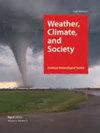印第安纳人每年都忘记如何在雪地里开车吗?
IF 1.9
4区 地球科学
Q3 ENVIRONMENTAL STUDIES
引用次数: 0
摘要
美国许多州的冬季都会下雪,随之而来的评论是,当这个季节的第一场雪出现时,司机们似乎总是“忘记”如何在雪地里开车。这项研究评估了2007年至2020年印第安纳州冬季这种流行情绪的准确性。将该季节第一场雪期间的机动车撞车、受伤和死亡人数与随后的降雪事件进行比较。构建了一个由46个单元格组成的网格来细分状态,并在研究期间每天在每个单元格中汇总降雪和撞车的实例。每个单元的每日碰撞、伤害和死亡总数通过各自的平均值和标准差进行归一化,从而允许将所有单元的数据合并为单个数据集。研究了4个积雪阈值:1、13、25和51 mm。每个阈值处的分布表明,无论使用何种累积阈值,冬季初雪日的平均撞车事故发生率高于其他降雪日。统计测试支持这一结果,显示在四个降雪量阈值中,每一个的平均撞车数之间存在显著差异。在第一个降雪日也有更多的伤害和更多的死亡,尽管死亡人数只在13毫米降雪阈值上显著。我研究的目的是为了回答这个问题:在印第安纳州,每年冬天下雪的第一天发生的机动车撞车事故是否比其他下雪的日子发生的撞车事故多?利用4个降雪量递增的降雪量阈值,对初雪日和其他降雪日的每日撞车事故进行统计检验,结果表明,无论积雪量如何,每年冬季降雪第一天的平均撞车事故数量都明显增加。这支持了一种流行的观点,即每年第一次下雪时车祸发生得更频繁,尽管这更可能是由于司机重新适应了下雪的路况,而不是由于健忘。本文章由计算机程序翻译,如有差异,请以英文原文为准。
Do Hoosiers Forget How to Drive in the Snow Each Year?
The winter season in many U.S. states includes snowfall, and with it comes comments about how drivers always seem to “forget” how to drive in snow when the first snowfall of the season occurs. This study assesses the accuracy of this popular sentiment during Indiana winters from 2007 to 2020. The number of motor vehicle crashes, injuries, and fatalities during the first snowfall of the season was compared with those during subsequent snow events. A grid of 46 cells was constructed to subdivide the state, and instances of snowfall and crashes were aggregated within each cell each day during the study period. Daily crash, injury, and fatality totals in each cell were normalized by their respective means and standard deviations, allowing for data from all cells to be combined into a single dataset. Four snow accumulation thresholds were examined: 1, 13, 25, and 51 mm. Distributions at each threshold show that more crashes occur on average on days with the first snowfall of the winter season than on other days with snowfall, regardless of the accumulation threshold used. Statistical tests support this result, showing significant differences between the mean numbers of crashes at each of the four snowfall thresholds. There were also significantly more injuries on the first snowfall day and more fatalities, although fatalities were only significant for the 13-mm snowfall threshold.
The purpose of my research is to answer the question: are there more motor vehicle crashes on the first day with snow each winter when compared with the number of crashes on other days with snowfall in the state of Indiana? Using four snowfall thresholds of increasing amounts, statistical tests comparing daily crashes on first snowfall and other snowfall days showed that there were significantly more crashes on average on the first day with snowfall each winter, regardless of the amount of snow accumulation. This supports the popular notion that crashes occur more frequently the first time it snows each year, although it is more likely attributed to drivers reacclimating to snowy road conditions than to forgetfulness.
求助全文
通过发布文献求助,成功后即可免费获取论文全文。
去求助
来源期刊

Weather Climate and Society
METEOROLOGY & ATMOSPHERIC SCIENCES-
CiteScore
3.40
自引率
13.60%
发文量
95
审稿时长
>12 weeks
期刊介绍:
Weather, Climate, and Society (WCAS) publishes research that encompasses economics, policy analysis, political science, history, and institutional, social, and behavioral scholarship relating to weather and climate, including climate change. Contributions must include original social science research, evidence-based analysis, and relevance to the interactions of weather and climate with society.
 求助内容:
求助内容: 应助结果提醒方式:
应助结果提醒方式:


